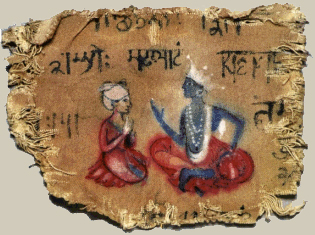
Like the headpiece to the Staff of Ra in Raiders of the Lost Ark, Indiana Jones is given a small artifact in Temple of Doom that aids him in quest to find the legendary treasure he seeks. Acquired from a near-death boy who barely escaped the clutches of Mola Ram, the cloth scrap, known as the Sanskrit Cloth, was described by Dr. Jones as “hundreds of years old.”

The prop is essentially a small swatch of tattered cloth or parchment with a painting depicting Sanskrit writing and Hindu mythology. First seen in the hands of the boy who gives it to Indy, the prop makes three more appearances in the film. Once very briefly in Indy’s hands on the hill looking over the village as he reflects on its meaning, a larger appearance at the campfire in the jungle where Indy shows and describes it to Willie and finally when Indy finds the secret passage in Willie’s room at Pangkot Palace with the wall painting that appears to be identical to the cloth.

According to Indiana Jones, the cloth depicts a seated Shiva bestowing the five sacred Sankara Stones to a devoted priest at the top of Mount Kalisa and commands him to “go forth and combat evil.”
In Willie’s palace chamber, Indy reads the wall and compares it to the cloth. He reads: “Follow in the footsteps of Shiva. Do not betray his truth.”

Interestingly, John Smith, the very man who was asked by the Temple of Doom production team to provide them with a Sanskrit version of these words, says the prop’s accuracy to Hindu mythology is questionable.
“I was approached sometime round then [1983] with a request to translate two sentences into Sanskrit. The first was “Follow in the path of Shiva”, or “Remain in the way of Shiva”, or something along those lines, and the second was “Do not betray his truth”. So I wrote a version out in marker pen on a piece of paper and sent it off. Obviously when the movie came out I went to see it, wondering if the mysterious sentences would appear. At a certain point a manuscript was mentioned, and some writing was very briefly shown. It was too quick to take it in full, but I did just have time to see that the props people had embellished at least one of the characters to make it look more interesting, and in doing so had turned it from a “pa” into a “ma”.”
Smith says while Indy describes Shiva on the cloth, the figure is actually that of the Hindu god Krishna, and that most of the text on the prop has faded and disappeared in the years since the film’s release.
“The first word, “śambhoh” (“Shiva’s”) can still be read…Then comes what was supposed to be my word for “way,” which was some form or other of Sankrit pathin/pathyā. This has turned into something looking like “mathyātam,” which is meaningless. After that there’s not enough left to read, though the large character next to Krishna’s elbow is a “ta,” and may the beginning of “tasya satyam” or “tatsatyam” (“his truth”).

